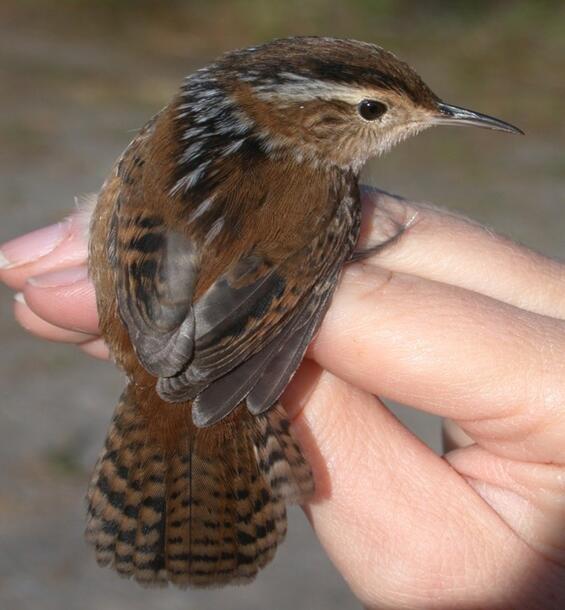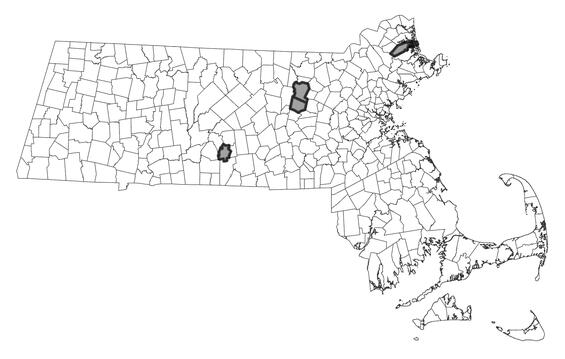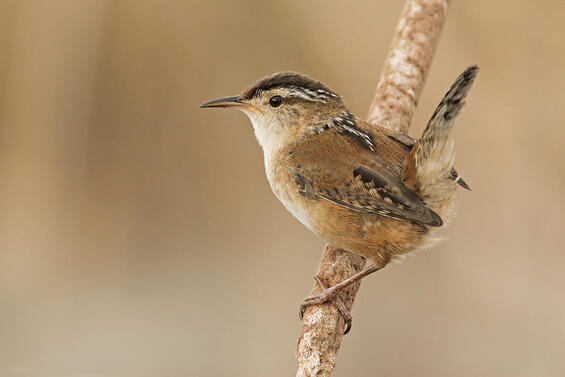- Scientific name: Cistothorus palustris
Species of Greatest Conservation Need (MA State Wildlife Action Plan)
Description

Marsh wren
The marsh wren (formerly long-billed marsh wren) is one of five wren species found in Massachusetts. Like the others, it is a chunky, brown songbird with a slender, slightly decurved bill and an often upturned tail. Measuring about 4 inches from bill to tail, the marsh wren has a plain, brown crown, a prominent white eye line, and a black triangle on its upper back, streaked with white. The underparts are largely whitish, but the belly and undertail coverts may be buff. The male's song, which may be heard day and night, is a series of loud, rapid notes with a quality that has been described as “reedy” and “liquid.”
Life cycle and behavior
In Massachusetts, males begin to arrive on their breeding grounds in late April. For reasons that are not well understood, each male constructs as many as ten dummy nests in his territory. Females arrive about ten days after the males and, after choosing a mate (one or more females to a male), construct the nests in which they will lay their eggs. Marsh wren nests are domed and elliptical, about 17 cm (7 in) tall and 7.5 cm (3 in) wide, with a side opening about 3.2 cm (1.25 in) across. They are made of woven cattails, reeds, and grasses, lashed to standing cattails or other plants, typically 0.3-0.9 m (1-3 ft) — but can be up to 1.8 m (6 ft) — above the water level. The lining (lacking in the dummy nests) consists of cattail down, other fine plant material, and feathers. Females lay clutches of 3-8 (typically 5), brown speckled eggs beginning in late May, incubating them for 12-16 days. Their young leave the nest after about two weeks, becoming independent after another week or so. There are two broods per year, with the last eggs hatching by the beginning of August. Departure for wintering grounds begins in August and continues through October. The diet of marsh wrens consists of insects and spiders gleaned from the water and marsh vegetation.
Population status
Marsh wrens are ranked G5, meaning they are considered to be secure on a global scale. They are locally common in New England, but their numbers are declining here as is generally the case in the eastern part of their range. Results of MassWildlife’s Natural Heritage Endangered Species Program (NHESP) surveys in 2008 and 2009 in the Housatonic Watershed are in line with Crowley’s earlier statewide inventory that found that the majority of marsh wrens in the Commonwealth occur at just a few sites in eastern Massachusetts. The remainder of the marsh wrens found were in much smaller satellite populations, a situation that may make the state population vulnerable.
Distribution and abundance
The marsh wren breeds in southwestern Canada, throughout the northern US, along the Pacific, Atlantic, and Gulf coasts, and in portions of Texas and Arizona. It can be found locally across much of Massachusetts but does not breed on Martha’s Vineyard or Nantucket. The marsh wren winters in coastal areas throughout its breeding range, and in inland habitat across Mexico and the southern US. Marsh wrens will occasionally overwinter in Massachusetts.

Distribution in Massachusetts. 1999-2024. Based on records in the Natural Heritage Database.
Habitat
Large freshwater, brackish, or salt marshes with an abundance of tall emergent vegetation (cattails, sedges, or rushes) are typical habitat for marsh wrens. They are particularly likely to use dense cattail beds with standing water between cattail hummocks. They may also be found among emergent vegetation along the margins of slow-moving rivers, ponds, and lakes.
This species prefers large marshes and is rarely found in wetlands smaller than 1 acre. Density of emergent vegetation is positively correlated with the number of young that fledge. In a study comparing bird use of cattail stands and areas invaded by Purple Loosestrife, marsh wrens used the former almost exclusively. Phragmites also alters their preferred habitat. Another study documented an inverse relationship between the likelihood of marsh wrens occurring in a wetland and the density of houses within 100 m (328 ft) of the wetland.
Healthy habitats are vital for supporting native wildlife and plants. Explore habitats and learn about conservation and restoration in Massachusetts.

Threats
Habitat loss is presumed to be the main threat to this species, particularly habitat conversion due to invasive species, which is expected to be exacerbated by climate change. Predation by domestic cats has been identified as the largest source of mortality for wild birds in the United States with the number of estimated mortalities exceeding 2 billion annually. Cats are especially a threat to those species that nest on or near the ground.
An additional threat to the species is collisions with buildings and other structures, as approximately 1 billion birds in the United States are estimated to die annually from building collisions. A high percentage of these collisions occur during the migratory periods when birds fly long distances between their wintering and breeding grounds. Light pollution exacerbates this threat for nocturnal migrants as it can disrupt their navigational capabilities and lure them into urban areas, increasing the risk of collisions or exhaustion from circling lit structures or areas.
Conservation
Marsh wrens conservation in Massachusetts requires preserving large, high-quality marshes with tall, dense vegetation and a substantial buffer of undeveloped upland. Management objectives should emphasize emergent marsh integrity, especially focused on invasives control. Inventory for new sites and regular monitoring of known sites are important for understanding marsh wren population dynamics and planning management where appropriate.
Promote responsible pet ownership that supports wildlife and pet health by keeping cats indoors and encouraging others to follow guidelines found at fishwildlife.org.
Bird collision mortalities can be minimized by making glass more visible to birds. This includes using bird-safe glass in new construction and retrofitting existing glass (e.g., screens, window decals) to make it bird-friendly and reducing artificial lighting around buildings (e.g., Lights Out Programs, utilizing down shielding lights) that attract birds during their nocturnal migration.
References
Crowley, S.K. 1994. Habitat use and population monitoring of secretive waterbirds in Massachusetts. MS Thesis, University of Massachusetts, Amherst.
Kroodsma, D.E. and J. Verner. 1997. Marsh wren (Cistothorus palustris), The Birds of North America Online (A. Poole, Ed.). Ithaca: Cornell Lab of Ornithology; Retrieved from the Birds of North America Online: http://bna.birds.cornell.edu/bna/species/308/
Contact
| Date published: | April 4, 2025 |
|---|